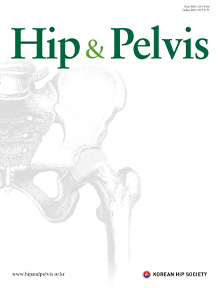Related article in
-
Original ArticleMarch 31, 2015
 0
0
 81
81
 21
21

Changes in Tip-Apex Distance by Position and Film Distance Measured by Picture Archiving and Communication System (PACS)
Kyu Yeol Lee, MD, Sung Soo Kim, MD, Hyeon Jun Kim, MD, Dong Ho Ha, MD*, Hyung Min Yoon, MD, Hyun Su Do, MD
Hip Pelvis 2015; 27(1): 36-42AbstractPurpose: The tip-apex distance (TAD) is used to predict the clinical outcome of intertrochanteric fracture fixation. We aimed to measure the changes in TAD by position and film distance using Picture Archiving and Communication System (PACS).
Materials and Methods: We used a femur replica with a 10°femoral neck anteversion and a 130°neck shaft angle. Proximal femoral nail antirotation nail and a helical blade were inserted into the replica. Radiographs were taken at the neutral position and after applying 10°, 20°, 30°, 40°internal/external rotation, 10°abduction, and 10°and 40°adduction to the mechanical axis. Radiographs were taken at the replica-film distance of 10 cm and 20 cm under the same conditions, mimicking the differences in Focus-film distance (FFD), which reflect the patient’s contour in clinical settings. A radiologist and an orthopedic surgeon measured the TAD twice using PACS. The average error was 2 mm (4.5%) and the standard error was ±3.04. TADs in the neutral position constituted the standard values to measure the relative errors.
Results: TADs increased with an increase in the external rotation and abduction of the replica. TADs decreased with an increase in the internal rotation and adduction of the replica. For comparable measurements, relative errors were higher at FFDs of 20 cm compared to FFDs of 10 cm.
Conclusion: Since the femur is internally rotated and adducted for reduction, orthopedic surgeons would assess the lag screw to be closer to the apex of femur on intraoperative radiographs. To have a correct measurement of the TAD after fixation of intertrochanteric fractures, radiographs should be taken in neutral position and measurement errors should be considered based on the patient’s size. -
Original ArticleDecember 31, 2015
 0
0
 63
63
 15
15

Does the Time of Postoperative Bisphosphonate Administration Affect the Bone Union in Osteoporotic Intertrochanteric Fracture of Femur?
Yoon Je Cho, MD, Young Soo Chun, MD*, Kee Hyung Rhyu, MD*, Joon Soon Kang, MD†, Gwang Young Jung, MD, Jun Hee Lee, MD
Hip Pelvis 2015; 27(4): 258-264AbstractPurpose: This study was designed to investigate the effect of bisphosphonate administration starting time on bone healing and to identify the best administration time following surgical treatment of osteoporotic intertrochanteric fractures.
Materials and Methods: Two hundreds and eighty four patients (284 hips; 52 males, 232 females) who underwent surgery following osteoporotic intertrochanteric fracture from December 2002 to December 2012 were retrospectively analyzed. The average follow-up period was 68.4 months. The patients were divided into three groups according to the time of bisphosphonate administration after operation: 1 week (group A; n=102), 1 month (group B; n=89), and 3 months (group C; n=93). Koval scores and change of Koval scores 1 year after operation were used for clinical evaluation. For radiologic evaluation, the time of callus appearance across the fracture line on sagittal and coronal radiographs and the time to absence of pain during hip motion was judged as the time of bone union.
Results: Koval scores one year after surgery for groups A, B, and C were 2.44, 2.36, and 2.43 (P=0.895), respectively. The mean time of union was 12.4, 11.9, and 12.3 weeks after operation in the three groups (P=0.883), respectively. There were zero cases of nonunion. There were 3, 5, and 7 cases of fixative displacement in the three groups, respectively, but the distribution showed no significant difference (P>0.472).
Conclusion: The initiating time of bisphosphonate administration following surgery does not affect the clinical outcomes in patients with osteoporotic intertrochanteric fracture. -
Original ArticleMarch 31, 2022
 0
0
 71
71
 21
21

Does Fracture Severity of Intertrochanteric Fracture in Elderly Caused by Low-Energy Trauma Affected by Gluteus Muscle Volume?
Byung-Kook Kim, MD, PhD, Suk Han Jung, MD
Hip Pelvis 2022; 34(1): 18-24 , Donghun Han, MDAbstractPurpose: The aim of this study was to determine whether there is a correlation between the type and stability of intertrochanteric fractures caused by low-energy trauma and gluteus muscle volume.
, Donghun Han, MDAbstractPurpose: The aim of this study was to determine whether there is a correlation between the type and stability of intertrochanteric fractures caused by low-energy trauma and gluteus muscle volume.
Materials and Methods: A total of 205 elderly (>65 years) patients with intertrochanteric fractures caused by low-energy trauma treated from January 2018 to December 2020 were included in this study. The mean age of patients was 81.24 years (range, 65-100 years). Fractures were classified according to the Jensen modification of the Evans classification. The cross-sectional area of the contralateral gluteus muscle (minimus, medius, and maximus) was measured in preoperative axial computed tomography slices. An analysis and comparison of age, body mass index (BMI), weight, height, and the gluteus muscle area in each fracture type group was performed.
Results: In the uni-variable analysis, statistically significant taller height was observed in patients in the stable intertrochanteric fracture (modified Evans 1 and 2) group compared with those in the unstable intertrochanteric fracture (modified Evans 3, 4, and 5) group (P<0.05). In addition, significantly higher BMI-adjusted gluteus muscle area (gluteus muscle area/BMI) was observed for the stable intertrochanteric fracture group compared with the unstable intertrochanteric fracture group except for the BMI-adjusted gluteus minimus area (P=0.112). In multivariable analysis, only the BMI-adjusted gluteus maximus (P=0.042) and total gluteus areas (P=0.035) were significantly higher in the stable group.
Conclusion: Gluteal muscularity around the hip, especially the gluteus maximus, had a significant effect on the stability of intertrochanteric fractures. -
Review ArticleDecember 1, 2011
 0
0
 59
59
 12
12
Fixing Leg Length Discrepancies after Total Hip Arthroplasty
Young Wook Lim, MD, Bum Yong Park, MD, Yong Sik Kim, MD
J Korean Hip Soc 2011; 23(4): 258-261Leg length discrepancies are a common cause of patient dissatisfaction after total hip arthroplasty (THA). The equalization of limb lengths and restoration of the anatomic geometry of the hip to restore normal gait and function are the primary goals during THA. Patients recognize a leg length discrepancy when one leg is shorter than the other by 6 mm or longer than the other by 10 mm after THA. Outside of this range, several problems would occur. Therefore, we should try to maintain leg length during THA via preoperative and intra-operative planning. -
Original ArticleSeptember 30, 2023
 0
0
 188
188
 30
30

Assessing the Necessity of Extra Reduction Aides in Intramedullary Nailing of Intertrochanteric Hip Fractures
John W. Yurek, DO
Hip Pelvis 2023; 35(3): 183-192 , Nikki A. Doerr, MS
, Nikki A. Doerr, MS  , Alex Tang, MD
, Alex Tang, MD  , Adam S. Kohring, DO
, Adam S. Kohring, DO  , Frank A. Liporace, MD
, Frank A. Liporace, MD  , Richard S. Yoon, MD
, Richard S. Yoon, MD  AbstractPurpose: This study aims to determine which intertrochanteric (IT) hip fracture and patient characteristics predict the necessity for adjunct reduction aides prior to prep and drape aiming for a more efficient surgery.
AbstractPurpose: This study aims to determine which intertrochanteric (IT) hip fracture and patient characteristics predict the necessity for adjunct reduction aides prior to prep and drape aiming for a more efficient surgery.
Materials and Methods: Institutional fracture registries from two academic medical centers from 2017-2022 were analyzed. Data on patient demographics, comorbidities, fracture patterns identified on radiographs including displacement of the lesser trochanter (LT), thin lateral wall (LW), reverse obliquity (RO), subtrochanteric extension (STE), and number of fracture parts were collected, and the need for additional aides following traction on fracture table were collected. Fractures were classified using the AO/OTA classification. Regression analyses identified significant risk factors for needing extra reduction aides.
Results: Of the 166 patients included, the average age was 80.84±12.7 years and BMI was 24.37±5.3 kg/m2. Univariate regression revealed increased irreducibility risk associated with RO (odds ratio [OR] 27.917, P≤ 0.001), LW (OR 24.882, P<0.001), and STE (OR 5.255, P=0.005). Multivariate analysis significantly correlated RO (OR 120.74, P<0.001) and thin LW (OR 131.14, P<0.001) with increased risk. However, STE (P=0.36) and LT displacement (P=0.77) weren’t significant. Fracture types 2.2, 3.2, and 3.3 displayed elevated risk (P<0.001), while no other factors increased risk.
Conclusion: Elderly patients with IT fractures with RO and/or thin LW are at higher risk of irreducibility, necessitating adjunct reduction aides. Other parameters showed no significant association, suggesting most fracture patterns can be achieved with traction manipulation alone. -
Original ArticleSeptember 30, 2023
 0
0
 160
160
 37
37

Risk Factors Associated with Fixation Failure in Intertrochanteric Fracture Treated with Cephalomedullary Nail
Hyung-Gon Ryu, MD
Hip Pelvis 2023; 35(3): 193-199 , Dae Won Shin, MD
, Dae Won Shin, MD  , Beom Su Han, MD
, Beom Su Han, MD  , Sang-Min Kim, MD*
, Sang-Min Kim, MD*  AbstractPurpose: Cephalomedullary (CM) nailing is widely performed in treatment of elderly patients with femoral intertrochanteric fractures. However, in cases of fixation failure, re-operation is usually necessary, thus determining factors that may contribute to fixation failure is important. In this study, we examined factors affecting the occurrence of fixation failure, such as age or fracture stability, after CM nailing in elderly patients.
AbstractPurpose: Cephalomedullary (CM) nailing is widely performed in treatment of elderly patients with femoral intertrochanteric fractures. However, in cases of fixation failure, re-operation is usually necessary, thus determining factors that may contribute to fixation failure is important. In this study, we examined factors affecting the occurrence of fixation failure, such as age or fracture stability, after CM nailing in elderly patients.
Materials and Methods: This study was conducted retrospectively using registered data. From April 2011 to December 2018, CM nailing was performed in 378 cases diagnosed with femoral intertrochanteric fractures, and 201 cases were finally registered. Cases involving patients who were bed-ridden before injury, who died from causes unrelated to surgery, and those with a follow-up period less than six months were excluded.
Results: Fixation failure occurred in eight cases. Comparison of the surgical success and fixation failure group showed that the mean age was significantly higher in the fixation failure group compared with the control group (81.3±6.4 vs. 86.4±6.8; P=0.034). A significantly high proportion of unstable fractures was also observed (139/54 vs. 3/5; P=0.040), with a significantly high ratio of intramedullary reduction (176/17 vs. 5/3; P=0.034). A significantly higher ratio of unstable fractures compared with that of stable fractures was observed in the intramedullary reduction group (132/49 vs. 10/10; P=0.033).
Conclusion: Fixation failure of CM nailing is likely to occur in patients who are elderly or have unstable fracture patterns. Thus, care should be taken in order to avoid intramedullary reduction.
- 1

Most Keyword
?
What is Most Keyword?
- It is most registrated keyword in articles at this journal during for 2 years.
Most View
-
Pathophysiology and Treatment of Gout Arthritis; including Gout Arthritis of Hip Joint: A Literature Review
Yonghan Cha, MD
Hip Pelvis 2024; 36(1): 1-11 , Jongwon Lee, MD
, Jongwon Lee, MD  , Wonsik Choy, MD
, Wonsik Choy, MD  , Jae Sun Lee, PhD*,†
, Jae Sun Lee, PhD*,†  , Hyun Hee Lee, MD‡
, Hyun Hee Lee, MD‡  , Dong-Sik Chae, MD‡
, Dong-Sik Chae, MD‡ 
-
Treatment of Osteoporosis after Hip Fracture: Survey of the Korean Hip Society
Jung-Wee Park, MD
Hip Pelvis 2024; 36(1): 62-69 , Je-Hyun Yoo, MD*
, Je-Hyun Yoo, MD*  , Young-Kyun Lee, MD
, Young-Kyun Lee, MD  , Jong-Seok Park, MD†
, Jong-Seok Park, MD†  , Ye-Yeon Won, MD‡
, Ye-Yeon Won, MD‡ 
Editorial Office




 Cite
Cite PDF
PDF



